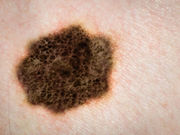Patients with vitiligo had higher objective response rate; prolonged progression-free, overall survival
WEDNESDAY, Aug. 24, 2016 (HealthDay News) — For patients with advanced melanoma, vitiligo occurrence is associated with favorable clinical outcome during nivolumab treatment, according to a study published online Aug. 11 in the Journal of Dermatology.
Yasuhiro Nakamura, M.D., Ph.D., from the Saitama Medical University International Medical Center in Japan, and colleagues examined the correlation between vitiligo occurrence and clinical benefit of nivolumab treatment in advanced melanoma. Data were included for 35 melanoma patients treated with nivolumab.
The researchers found that 25.7 percent of patients developed vitiligo during treatment. The time to occurrence of vitiligo varied from two to nine months from the start of treatment (mean, 5.2 months). Two of the nine patients who developed vitiligo had a complete response to nivolumab, while two had a partial response. Patients with vitiligo had a significantly higher objective response rate than those without vitiligo (44.4 versus 7.7 percent; P = 0.027). For patients achieving an objective response, the mean time to vitiligo occurrence was significantly less than in those with no response (3.1 versus 6.8 months; P = 0.004). There were significant associations for vitiligo occurrence with prolonged progression-free and overall survival (hazard ratios, 0.24 and 0.16, respectively). Vitiligo was not associated with a statistically significant overall survival benefit at the 20-week landmark analysis (P = 0.28).
“The occurrence of vitiligo during nivolumab treatment may be correlated with favorable clinical outcome,” the authors write.
Two authors disclosed financial ties to the pharmaceutical industry.
Copyright © 2016 HealthDay. All rights reserved.








